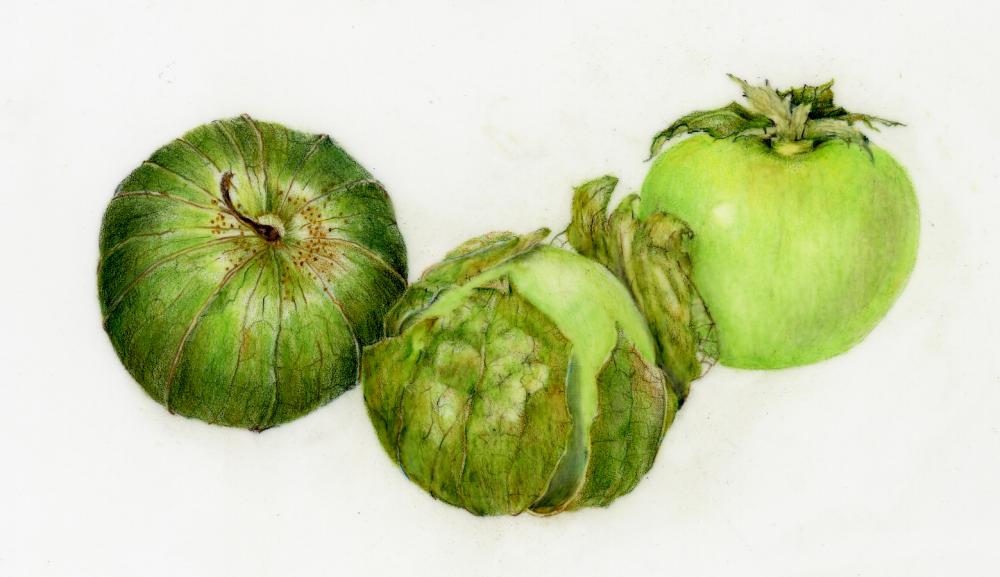There’s a surprisingly intimate and uplifting show at the Talbot County Public Library. On view through January 29. the botanical art of Lee B. D’Zmura and Anna G. Harding unfolds with portrait after portrait of native plants, garden flowers, fungi, butterflies, bees, and an array of fruits and vegetables.
Entitled “An Art for All Seasons,” this extensive show includes meticulous colored pencil drawings and watercolors so colorful, detailed and deliciously lush that you can get lost in each and every one. From its explosions of intricately striped red and white petals to its papery dried sepals, D’Zmura’s “Amaryllis” is a jaw dropper, while across the room, Harding presents a quintessentially elegant depiction of our native trumpet vine, complete with vivid orange tubular blossoms and graceful, deep green leaves nibbled here and there by insects.
The two artists have included some short bits of text that reveal the thoughts behind their approach. One, a quote from Georgia O’Keefe, says “No one sees a flower really; it’s so small. We haven’t time, and to see takes time—like to have a friend takes time.”
D’Zmura and Harding approach their plants with considerable fondness and often with humor. Historically, botanical art is a method of plant identification and classification that requires a knowledge of botany, disciplined pencil and watercolor techniques, sharp eyes, and a steady hand. But although both artists are skilled in this painstaking process, they go beyond the simply informational or decorative to explore changing seasons, invading insects, decay and new growth—in short, they tell not only about the visual characteristics of these plants, they hone in on the lives and character of their subjects.
D’Zmura’s “Golden Beet,” bristling with hairy rootlets and multiple sturdy stems is comically stoic, and her “Tomatillos” seem to be engaged in an animated conversation. And in the epitome of optimism, two fragile new leaves sprout directly from a half-healed wound amid labyrinthine patterns of bark in her watercolor, “Silver Maple.”
There’s something fascinatingly grotesque yet beautiful about Harding’s graphite drawing, “Goldenrod Bunch Gall,” a tour-de-force in rendering the complexity of abnormal leaf growth caused by an egg-laying insect. While much of its energy went into this compensating growth, the goldenrod still mustered the fortitude to grow a small blossom which appears like a triumphant, if tiny, flourish lifting above the gall.
Harding’s passion for botanical art began eight years ago when she was concurrently enrolled in the Maryland Master Naturalist program and a botanical art class that D’Zmura was teaching.
She explained, “The two classes were very interdependent for me in terms of awakening to the mysteries of the natural world and learning to depict them.”
D’Zmura earned a Certificate in Botanical Art in 2008 from Brookside Gardens School of Botanical Art and Illustration and went on to teach there and at Adkins Arboretum. Much of her recent work is concerned with the concept of Wabi-Sabi and the natural cycles of growth, aging and decay.
A short paragraph posted on the wall explains, “Wabi-Sabi is an ancient Japanese art aesthetic which embraces beauty as imperfect, impermanent and incomplete. It is the acceptance of the beauty found in imperfection and the natural cycle of growth and decay, of aging with dignity and grace.”
Throughout their paintings and drawings, both artists celebrate these natural changes. There’s the luscious, dead-ripe fruit in Harding’s “Paw Paw,” the bare, sweeping stems of D’Zmura’s “Single Anemone” with its cluster of dried leaves so exquisitely delicate that you can almost feel them crinkle, and the startlingly dramatic fan striped with blue, black and white in Harding’s “Blue Jay Wing.” These are not idealized nature portraits. They show the flaws and tell the stories of the lives of their subjects. Rich and thought-provoking, they will invite you to slow down, look closely and deepen your understanding of the cycles of nature.
Mary McCoy is an artist and writer who has the good fortune to live beside an old steamboat wharf on the Chester River. She is a former art critic for the Washington Post and several art publications. She enjoys the kayaking the river and walking her family farm where she collects ideas and materials for the environmental art she creates, often in collaboration with her husband Howard. They have exhibited their work in the U.S., Ireland, Wales and New Zealand.
Don’t miss the latest! You can subscribe to The Chestertown Spy‘s free Daily Intelligence Report here.





Write a Letter to the Editor on this Article
We encourage readers to offer their point of view on this article by submitting the following form. Editing is sometimes necessary and is done at the discretion of the editorial staff.